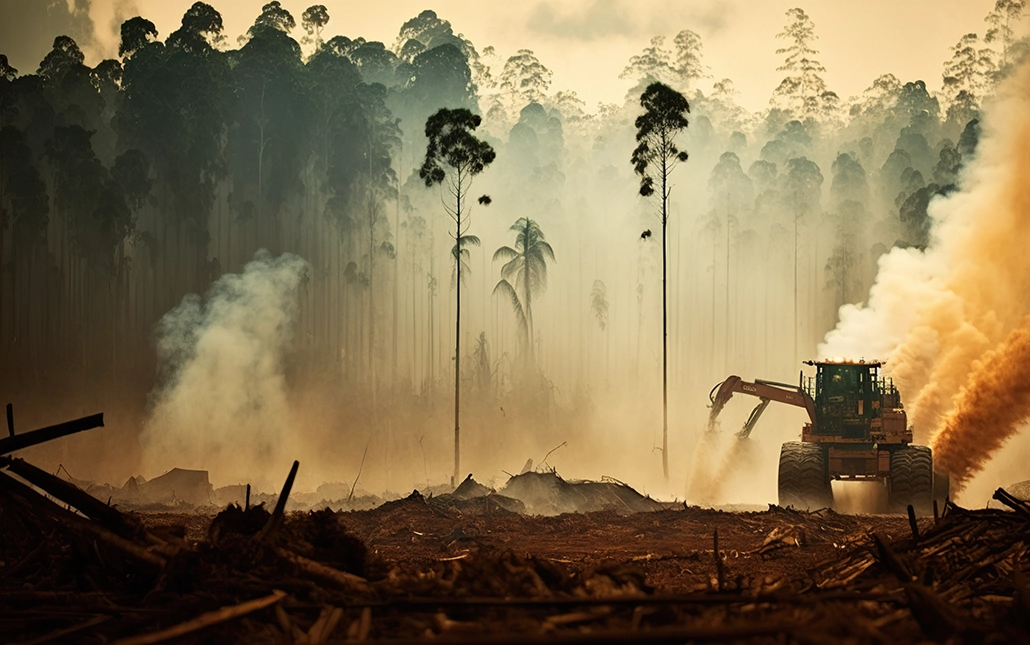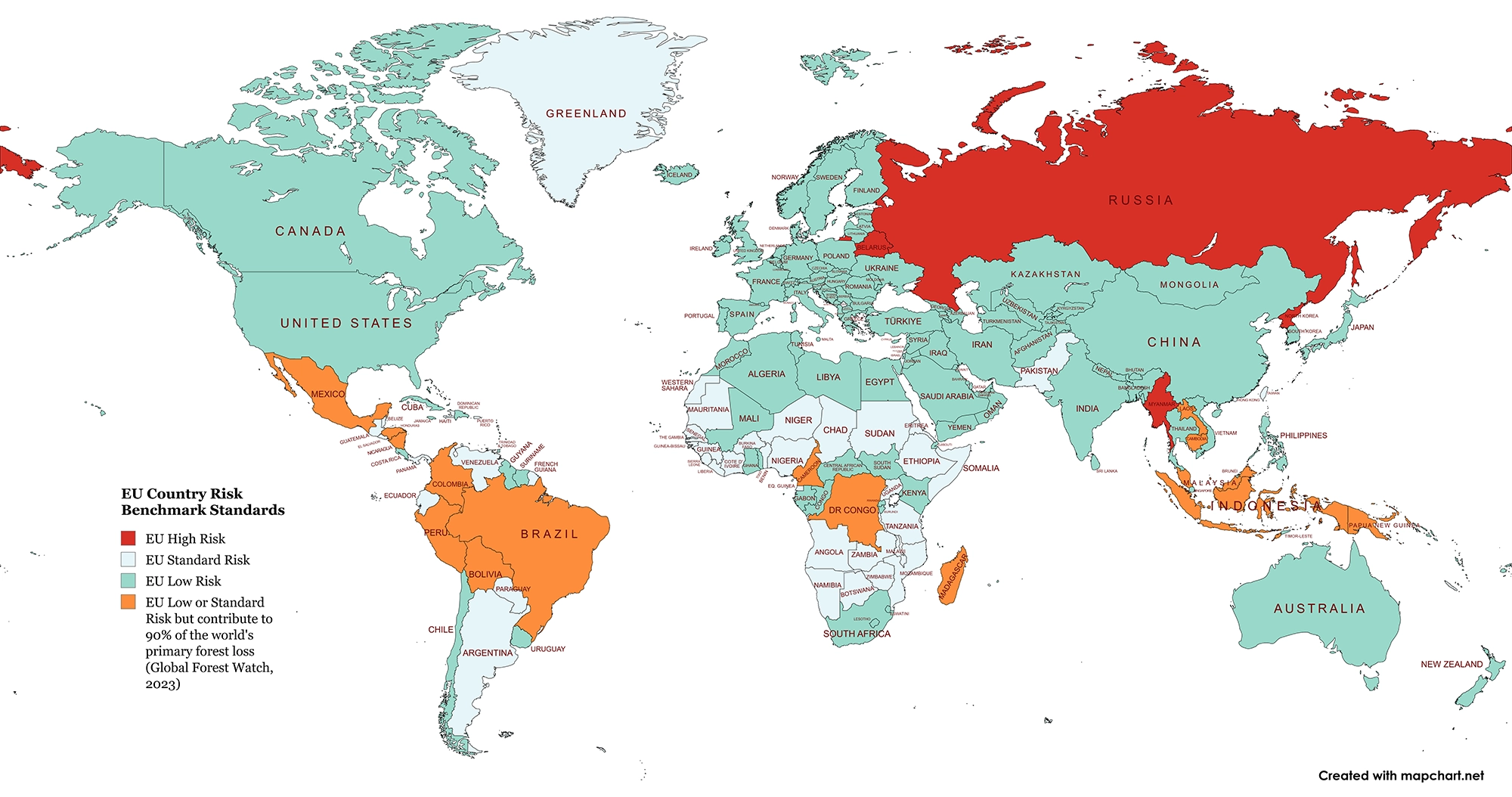EUDR countdown: preparing for compliance
News story
6 June 2025
With just over six months until the EU Deforestation Regulation (EUDR) takes effect for medium and large companies, every new piece of guidance provides greater clarity on what businesses need to do to ensure their supply chains are not contributing to global forest loss.
Last month, the EU published updated guidance that provides a range of clarifications that resulted in significant simplification for non-importers and businesses buying regulated products already on the EU market, such as consumer goods companies and retailers. In May, another key element in enabling full implementation was published: country risk classifications. These provide companies with an initial assessment of the level of deforestation and legality risks, as determined by the European Commission.
With risk assessments now fully able to be undertaken by companies, now is the time to act. This article outlines 3Keel’s essential information to help you prepare.
What is EUDR?
The EU Deforestation Regulation (EUDR) is landmark legislation designed to curb global deforestation by ensuring that supply for the EU market does not act as a driver of forest loss. It applies to a defined set of commodities – cattle, soy, palm oil, coffee, cocoa, rubber, and wood – and certain derivatives or products entering or leaving the EU market. Non-compliance may result in fines of up to 4% of annual EU turnover, exclusion from tenders, and even goods confiscation.
From 30 December 2025, companies placing these products on the EU market must conduct due diligence to ensure that the products:
- Are deforestation-free, meaning produced on land not subject to deforestation after 31 December 2020; and
- Have been legally produced, in line with the laws of the country of origin.
Country Risk Classification Update
The European Commission has now published its first round of country benchmarking, classifying nations into three risk levels: low, standard, and high. This risk designation determines the level of due diligence companies must undertake when sourcing from these countries.
What the risk categories mean
- Low risk countries: Require simplified due diligence. Companies need to gather specific information from the supply chain, but no detailed risk assessment or mitigation is required.
- Standard risk countries: Require full due diligence, including risk assessments and mitigation steps.
- High risk countries: Also require full due diligence, and will be subject to the most stringent checks, including potential for greater scrutiny by EU authorities.
From a practical perspective, businesses should understand two key points:
- Geolocation information and traceability is required regardless of country risk classification
- There is no difference between Standard and High Risk country designations when it comes to company monitoring and mitigation of deforestation risk.
Key updates
- Only four countries are currently designated as high-risk: Belarus, Myanmar, North Korea, and Russia. These four countries are estimated to contribute to 0.07% of EU imports of the seven regulated commodities.
- All EU Member States are considered low risk, along with over 100 other countries, including Canada, the UK, and the US.
- The Commission has stated that countries not explicitly listed as high or low risk are assumed to be standard risk. This includes most tropical commodity producers, including those with significant deforestation risk such as Brazil, Indonesia, the Democratic Republic of Congo, and Malaysia.
An evolving picture
This is the first publication of the EU’s Country Classification List. Its launch includes the publication of the assessment methodology used, which may be subject to update. In our opinion, the first exercise has some unusual country designations that are not always consistent with what we see happening in global deforestation datasets linked to the regulated commodities. For example, Papua New Guinea is classified as Low Risk despite being highlighted as a being a significant area of concern by some civil society groups and Global Forest Watch tracking persistent annual losses.
What businesses need to do
While the new country classifications provide some clarity, they don’t remove the need for all companies trading in the regulated commodities and products to act, even when sourcing solely from low-risk countries. Here’s what the update really means for due diligence planning.
1. Act now
Cross-functional alignment is critical. Legal, procurement, sustainability, and compliance teams must know their roles, timelines, and documentation duties. Now that the country risk classifications are public, businesses have everything they need to ramp up preparation before the 30th December 2025. The next six months provide an opportunity to make headway on data collection, ensure the supply chain is prepared and put in place a robust governance and management framework.
2. Make sure your risk assessment is fit for purpose
Companies need to ensure that their risk systems remain dynamic to account for changes in this list in the future and to maintain the resilience of their supply chains. A tick box approach may leave companies exposed, given the gap between what may be the difference between a real deforestation risk compared to the level of risk indicated by the EUDR country classifications.
Sourcing from a country classified as low risk under the EUDR benchmarking process does not exempt a company from having to take any action. Businesses still need to ensure deforestation-free and legal origin – the difference lies in how deeply they need to assess risk.
Watch out for:
- Mislabelling or circumvention: For example, China is low risk, but it imports and processes significant volumes of commodities from higher-risk countries. Traceability to plot level still applies to these volumes, and the deforestation risk applies to the country of origin – don’t rely on the final processing location.
- Aggregated supply chains: Ensure it is possible to identify and separate materials of differing origin/risk levels. Supply chain mixing is highlighted as a potential risk factor, and data is needed for all original production locations.
3. Implement your traceability and due diligence system
EUDR requires full traceability to the plot of land where the commodities were produced. Businesses must therefore establish robust systems to collect, store, and analyse supplier data. Relying on certification alone does not ensure compliance. It does not matter what the country classification is, all companies obligated under the EUDR must have traceability, or be able to receive and transmit due diligence statement reference numbers, for any regulated material placed on the EU market.
Looking ahead
The urgency behind the EUDR is clear. A recent report from WRI reported the tropics lost a record-shattering 6.7 million hectares of primary rainforest in 2024, an area nearly the size of Panama, and WWF has shown that the EU is the second largest importer of deforested agricultural goods behind China.
The EUDR is a step toward addressing deforestation, but putting it into practice requires dedicated time and knowledge-building. What’s clear is that businesses need to move from planning to implementation -fast.
If you would like to discuss how EUDR applies to your business; want to sense-check your current approach; or need support for effective implementation, we’re happy to talk.
Get in touch with us at commodities@3keel.com or call +44 1865 236500




